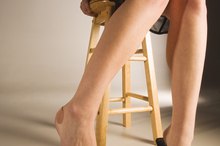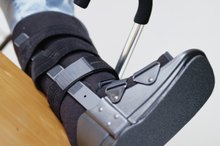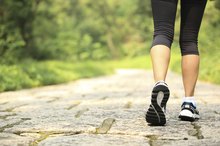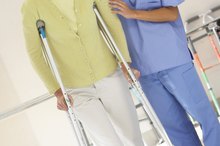Can You Still Keep Thin & Fit With Crutches?
If you've broken your leg or fractured your ankle and are depending on crutches to get around, don't resign yourself to an extended period of physical inactivity and weight gain. The nature of your injury may prevent you from doing the type of exercise you're used to, and you'll need to consult with your doctor about which exercises are appropriate for you and how much you should do, but it's perfectly possible to stay thin and fit with crutches.
Diet and Exercise
As you think about ways to exercise while injured, consider making some modifications to your diet. Losing or maintaining weight is a matter of balancing the number of calories you consume with the number of calories you burn each day. If you'll be spending more time than usual confined to your bed or sofa, stock your home with healthy fat-free snacks — lots of fruits, vegetables, nuts and legumes. Don't eliminate your favorite comfort foods completely, but moderate your portion sizes, keeping in mind that the boredom of being laid up might compel you to overindulge if you're not conscientious.
- As you think about ways to exercise while injured, consider making some modifications to your diet.
- Don't eliminate your favorite comfort foods completely, but moderate your portion sizes, keeping in mind that the boredom of being laid up might compel you to overindulge if you're not conscientious.
Walking
What to Wear After Rotator Cuff Surgery
Learn More
The fact that walking with crutches is more strenuous than normal walking works to your advantage when it comes to staying thin and fit. A 1987 University of Southern California study found that people who walk with a crutch raise their heart rates an average of 53 percent above the normal heart rate for walking — and the higher your heart rate, the more calories you burn.
Climbing Stairs
If you really want to get your heart pumping, try climbing stairs — though you may want to have a spotter if you're still wobbly on your crutches. Ideally, you'll work out on stairs that have a handrail, leaning your weight on the rail with one hand while keeping your crutches tucked under the opposite arm and hopping up each step on your good leg. If the staircase doesn't have a handrail — and if you're nimble enough — place your crutches on either side of you on each step and lift your weight against them, hopping to the next step with your good leg.
Resistance Exercise
What Exercises Can You Do With a Broken Toe?
Learn More
To keep your arm muscles firm, use resistance bands or weights and do arm curls. If you don't have weights, fill a milk jug or bottle with sand until it weighs enough to give you a good workout. You can also do wall pushups. Stand on your good leg, a little more than arm's length away from the wall, and push your body back and forth against the wall. Use a tennis ball or stress ball for squeezing exercises to keep your forearms trim.
- To keep your arm muscles firm, use resistance bands or weights and do arm curls.
Related Articles
References
- Journal of Orthopedic Trauma: Energy Cost of Three-Point Crutch Ambulation on Fracture Patients
- American Academy of Orthopedic Surgeons: How to Use Crutches, Canes and Walkers
- National Institute on Aging: Sample Exercises -- Strength
- Help Guide: Easy Tips for Planning a Healthy Diet and Sticking to It
- American Academy of Orthopaedic Surgeons. How to use crutches, canes, and walkers. Updated February 2015.
Writer Bio
Scott Roberts studied communications at the University of Southern Indiana and has written for local newspapers throughout his adult life. He has created articles for more than 70 international clients. An accomplished artist, he has illustrated and written cartoons for newspapers and GoComics.com. He lives in Southwest Michigan.









